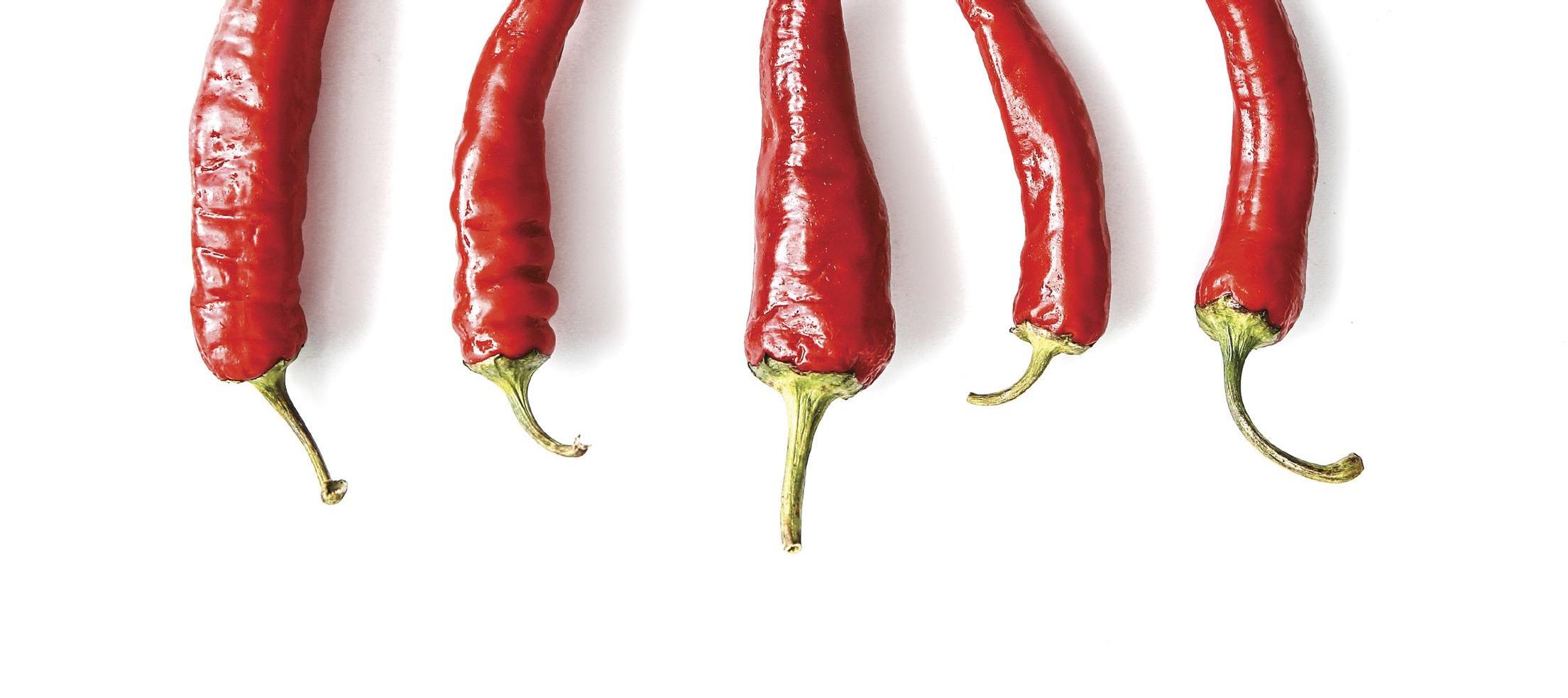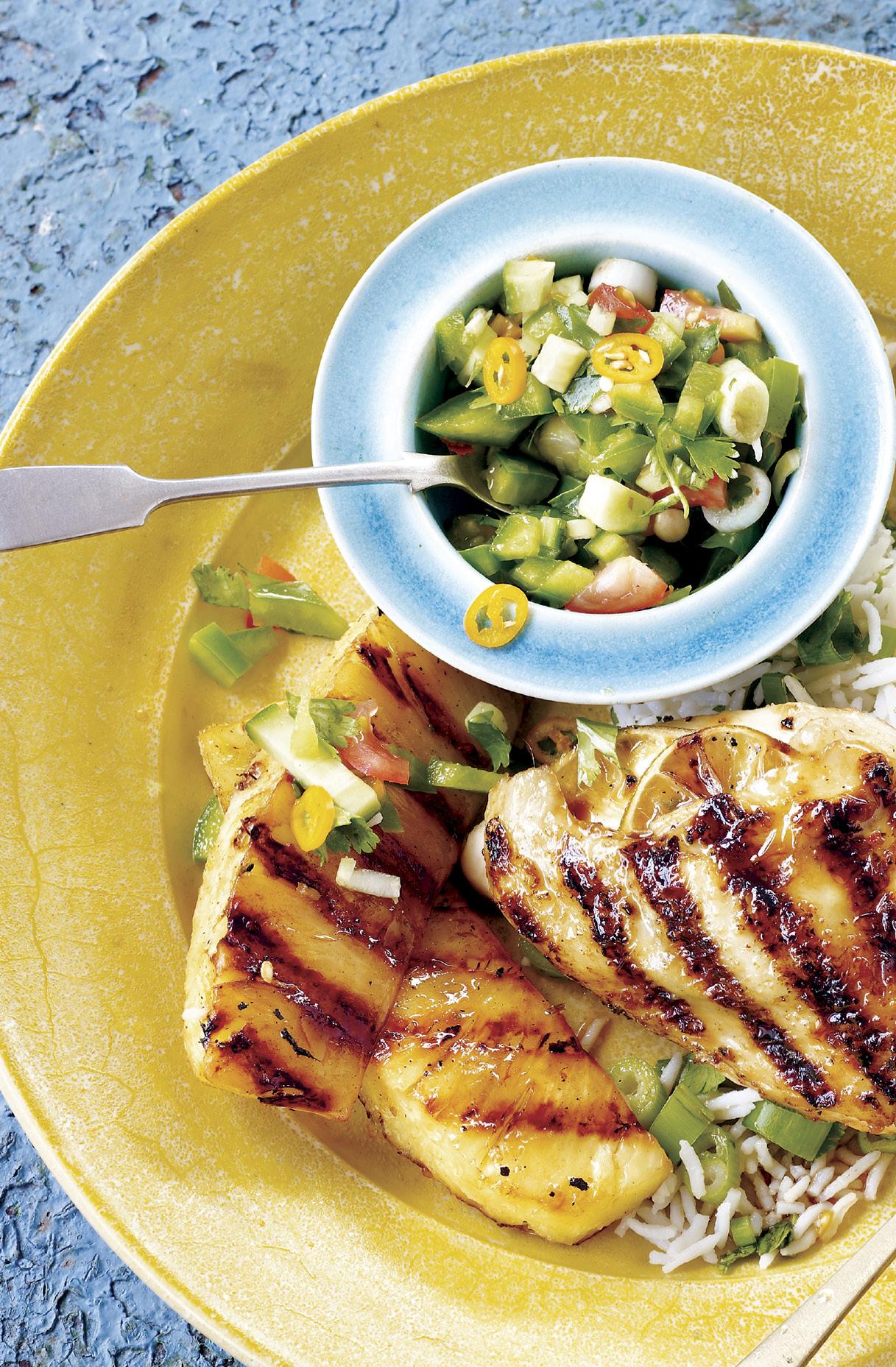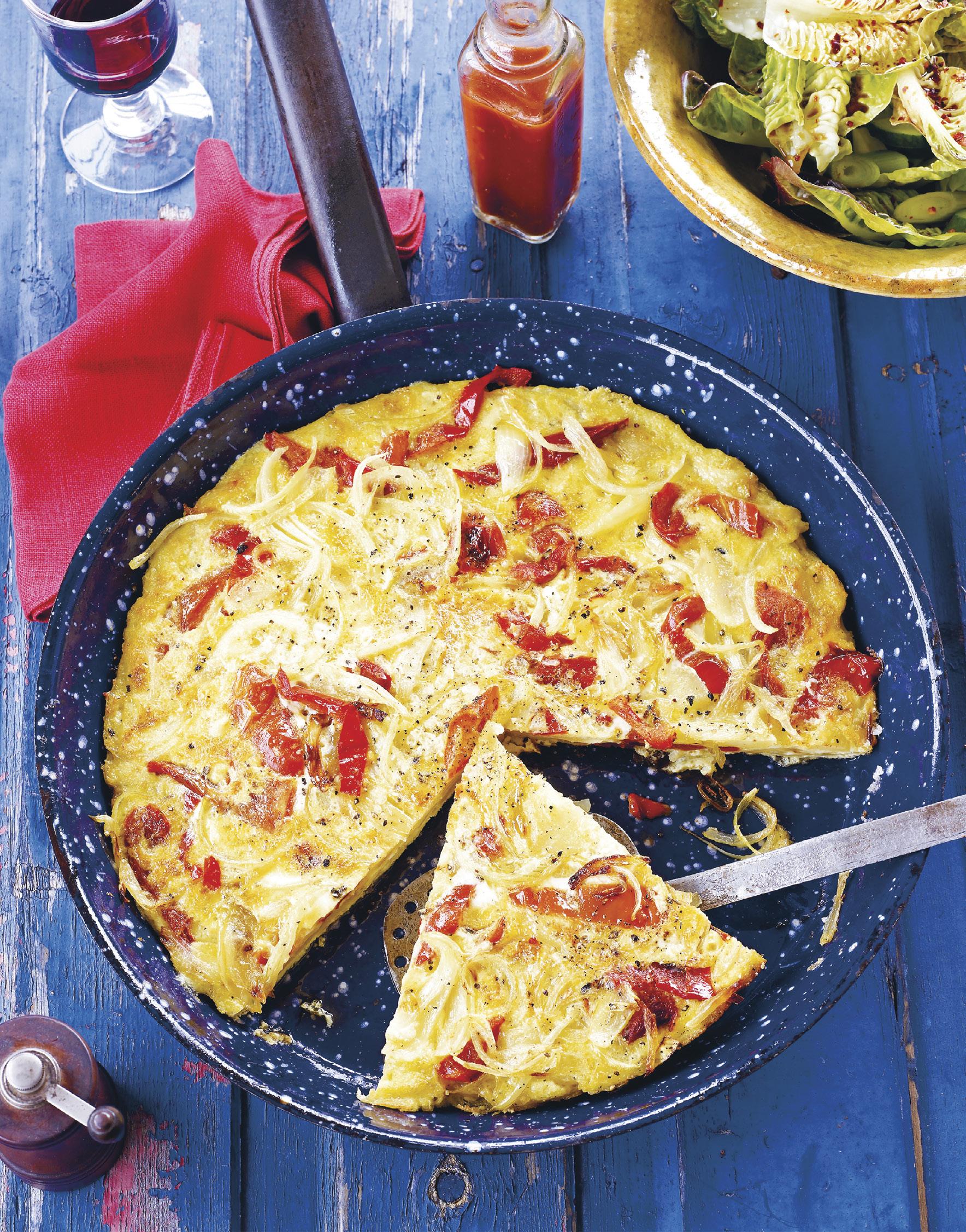
14 minute read
Hot Summer Entrees
Cooking up fiery dishes is easy with so many chili varieties to choose from
Like any lover of spicy food will tell you, not all chili peppers are created equally. As one of the oldest cultivated crops in the Americas, chili peppers have been a part of the human diet since approximately 7500 B.C., and the heat they bring to cuisine ranges from mild and sweet to dangerously hot and spicy.
The human fascination with heat boils down to hormones. When you eat a chili, the pain receptors in your mouth, nose and stomach are alerted—these cells tell the brain to release endorphins into the body. Dan May, the author of the “Red Hot Cookbook,” says that this hormone release creates the thrill chili eaters love so much: “The rush of these natural painkillers often produces a feeling of great well-being, and it’s this sensation that frequent consumers of hot chilies can become addicted to.”
As a bonus, chilies have dietary benefits, too. They are cholesterol free, low sodium, low calorie, and a good source of folic acid, potassium and vitamin E. Green chilies have about twice as much vitamin C in comparison to citrus fruit, and red chilies contain more vitamin A than carrots. When it comes to measuring heat, chili peppers are rated on the internationally recognized Scoville Heat Units (SHU), so you can know what to expect before purchasing or consuming. From the mild piquillo (with no heat at all) and the jalapeño pepper (2,500 to 8,000 SHU) to the on-fire Scotch Bonnet (80,000 to 400,000 SHU), there is a pepper out there for everyone’s comfort level.
To add some spice to your own summer menu, try these recipes from the “Red Hot Cookbook.” If you’re hosting a get-together, make sure to prepare your guests for the heat—and keep cold milk on hand if it gets to be a little too much. —Katie Ballalatak
Jerk is a style of cooking native to the Caribbean island of Jamaica. Traditionally chicken or pork was marinated in a mixture of ground pimento berries and Scotch Bonnet chilies, then cooked and smoked in equal proportion over a fire of pimento wood to which the leaves and berries were also added. This gave the meat a very distinctive taste. In more modern times (and outside the Caribbean) the term “jerk” refers more to the marinade used to flavor and tenderize the meat prior to cooking.

4 free-range chicken breasts, skin on 2⁄3 cups Jamaican Jerk Marinade (See recipe at right) 1 lime, ½ thinly sliced and ½ freshly squeezed 1 tablespoon dark rum 1 teaspoon dark soy sauce 1 teaspoon dark brown sugar ½ pineapple, peeled, cored and cut into wedges peanut oil, for greasing (optional) Green Pepper, Tomato & Habanero Chilli Salsa, to serve (See recipe at right) rice salad, to serve
1. Put the chicken in a bowl and cover with the Jamaican Jerk Marinade. Make sure the chicken is thoroughly coated, then cover and marinate in the refrigerator for at least 2 hours; overnight is ideal. 2. Remove the chicken from the marinade (reserve the marinade). Gently lift the edge of the skin on each chicken breast, creating a small pocket against the flesh. Take 1 to 2 thin slices of lime (1 for a small piece of chicken and 2 for a large) and slide these under the skin. These will caramelize during cooking. 3. You can roast, griddle or grill the chicken. • If roasting: Preheat the oven to 375ºF. Put the chicken in a roasting dish. Spoon a few tablespoons of the marinade over the chicken. Roast in the preheated oven for 35 to 40 minutes or until fully cooked and the juices run clear. Baste the chicken with the marinade as it roasts. The chicken will become quite dark in places while cooking; this is normal, but if you wish to avoid it, cover the pan with foil for the first 25 minutes of cooking. • If cooking on a ridged stovetop grill pan: Heat the pan, adding a little peanut oil if you like. Once hot, sear the chicken on both sides, then lower the heat and cook for about 8 to 10 minutes each side. On the grill, over medium heat, the chicken should take about 10 minutes each side; the juices in the middle should run clear. • If barbecuing or griddling: Baste with the marinade several times during cooking. Please note that this marinade was in contact with uncooked chicken, so always allow 5 to 10 minutes between the last time you baste and the end of cooking to ensure the marinade itself is thoroughly cooked. 4. Mix the lime juice, rum, soy sauce and sugar in a bowl and add the pineapple wedges. Mix to coat thoroughly. Remove the wedges from this mixture, paint with a little peanut oil and place on a hot stovetop grill pan or on the barbecue to lightly and evenly char. 5. Serve the chicken with the caramelized pineapple, Green Pepper, Tomato & Habanero Chilli Salsa, and a rice salad.
JERK CHICKEN WITH LIME & CARAMELIZED PINEAPPLE

IF YOUR MOUTH IS ON FIRE:
Drinking water to combat the heat will actually make it worse since capsaicin (the natural chemical compound that gives chilies their heat) is not soluable in water. Instead, try cold milk or yogurt. Swishing around a small amount of vegetable oil in your mouth and then spitting it out is also an effective remedy for a mouth on fire.
Jamaican Jerk Marinade MAKES 1½ CUPS
This makes a lovely hot marinade! By a long and exhaustive process of elimination, I seem to find myself instinctively mistrusting people who tell me they can’t eat spicy food—as far as I have ever seen, it just does you good. This recipe is therefore something of a litmus test when inviting new friends around for dinner. I am not, of course, suggesting that you shouldn’t have friends who avoid spicy food, just that it’s probably best not to leave them alone with the single malt after dinner!
2 teaspoons ground allspice 1 tablespoon black peppercorns 1 teaspoon grated nutmeg 1 teaspoon ground cinnamon 1 teaspoon sea salt 3 Scotch Bonnet chilies, roughly chopped (See Editor’s Note) 10 scallions, roughly chopped ½ onion, roughly chopped 4 garlic cloves, sliced 2 inches of fresh ginger, peeled and chopped small bunch of fresh thyme, chopped 4 fresh bay leaves, torn 2 tablespoons molasses 1⁄3 cup freshly squeezed lime juice 1⁄3 cup sunflower oil 1 tablespoon dark rum
1. Toast the ground allspice in a hot, dry, heavybased saucepan over medium heat. When it is ready, it will release a strong aroma. Grind the allspice and peppercorns with a pestle and mortar or a spice grinder until they become quite powdery. 2. Blend all the ingredients together in a food processor or with a hand blender to form a smooth, thick paste. Place in a clean, airtight container and refrigerate. The flavor of the marinade will improve over time and it will keep refrigerated for at least 4 weeks.
Cook’s Notes:
• This marinade is extremely hot and is great for chicken or pork. • If you do not have molasses on hand, use pure maple syrup. Editor’s Note: As a substitute for the Scotch Bonnet use habanero peppers, which also have a fruity character suited to the recipe. Jalapeño and serrano peppers are also great choices for a less heatintense dish.
Green Pepper, Tomato & Habanero Chilli Salsa MAKES 1 TO 2 CUPS
Real salsas are at their best just after they are made. Once you have experienced these feisty, zingy flavors, you will never go back to supermarket salsa! In addition to serving with the Jerk Chicken, eat in burritos or with a plate of nachos.
2 green bell peppers 1 (4-ounce) cucumber 4 plum tomatoes 2 shallots, finely chopped 1 garlic clove, crushed handful of fresh flat leaf parsley, chopped 1 habanero or Scotch Bonnet chilli, very finely chopped grated zest and freshly squeezed juice of 1 lime 4 tablespoons olive oil 2 tablespoons red wine vinegar sea salt and freshly ground black pepper, to taste
1. Peel, deseed and dice the bell peppers, cucumber and plum tomatoes. 2. In a large bowl, combine the shallots, peppers, cucumber, tomatoes, garlic and parsley. Add the chilli, mix thoroughly and season with salt and pepper, to taste. Put the lime zest and juice, oil and vinegar into a small bowl, whisk together to make a dressing and add to the salsa. Toss together well and serve as soon as possible.
Thai-spiced Rare Beef & Warm Rice Noodle Salad MAKES 4 SERVINGS
One of the most enjoyable elements of drifting from a relatively solitary profession like photography to food has been the extraordinary social whirlwind that it seems to create. I have been fortunate to become friends with many astonishingly talented and generous folk over the past years and probably none more so than Owen Potts, who is the source of this recipe. Despite surrounding himself with perpetual frenetic activity, Owen is never too busy for a chat or a beer; or even to drive 300 miles to help spit-roast a pig … but that’s another story. This recipe makes a deliciously different and tasty oriental variation on a simple salad.
14-ounce fillet steak/beef tenderloin 1 tablespoon sunflower oil 2 ounces bamboo shoots, finely shredded 3 cups roasted salted peanuts, coarsely ground 2 ounces baby spinach leaves 1 pound thin rice noodles 1 teaspoon toasted sesame oil 8 scallions, thinly sliced 3 tablespoons Nuoc Cham (See recipe at right) 2 handfuls of fresh cilantro, finely chopped 2-3 baby zucchini (about 2 ounces), sliced into ribbons with a mandolin or potato slicer freshly squeezed juice of 1⁄2 lime a pinch of salt 2 thin red chilies, very thinly sliced
For the Marinade 1 lemongrass stick, very finely chopped 2 teaspoons Thai red curry paste 2 teaspoons Thai fish sauce freshly squeezed juice of 1⁄2 lime
1. To make the marinade, mix the lemongrass, curry paste, fish sauce and lime juice, then place the beef in a shallow dish and cover with the marinade. Cover and refrigerate for as long as possible (30 minutes is OK; overnight would be superb). 2. Heat the oil in a frying pan over medium heat and fry the marinated beef (reserving any remaining marinade) for 2 minutes each side. Remove from the pan, cover and set aside. In the same pan, quickly fry the bamboo shoots and peanuts with any remaining marinade. Add the spinach to the pan, immediately remove from the heat and cover with a lid to allow the spinach to wilt in the residual heat. 3. Blanch the noodles in a pan of boiling water for 5 minutes or until cooked. Drain and toss in the sesame oil, scallions, Nuoc Cham and half the coriander/cilantro. Meanwhile, thinly slice the beef and keep warm. 4. Dress the zucchini with the lime juice, the remaining coriander/cilantro and the salt. 5. To assemble, divide the noodles among 4 warm plates, then pile the remaining ingredients on top. Garnish with the sliced chilies.
Cook’s Notes:
• This recipe would also work extremely well with skinless chicken breast. Unlike the beef which can be served rare, it is important to ensure that the chicken is thoroughly cooked through before serving. • Recommended chilies: Thai hot or Bird’s Eye
Nuoc Cham, or Vietnamese-style Dipping Sauce MAKES 2/3 CUPS
Vietnamese cuisine is one of the most interesting and diverse in the world. Nuoc Cham and its variations are now perhaps Vietnam’s most universally available sauces and are added as required to virtually any savory dish. It is particularly good when drizzled over rice dishes or as a dip for vegetable tempura.
1 small lime 3 garlic cloves, crushed 2 small hot green chilies, deseeded and finely chopped 4 teaspoons raw cane sugar ¼ cup Vietnamese-style fish sauce (See Cook’s Notes)
1. Squeeze the juice from the lime into a small bowl and set aside. 2. Scrape the pulp from the lime and grind it, along with the garlic and chilies, with a pestle and mortar to form a paste. If you find it difficult to get a paste, the ingredients could be briefly pulsed in a food processor. Add 1⁄3 cup water and the sugar to the bowl of lime juice and stir until the sugar has dissolved. Scrape the chilli paste into the bowl, add the fish sauce and mix well.
Cook’s Notes:
• Add the finely chopped chilies to the bowl at the end if you prefer not to grind them into the Nuoc Cham. • Vietnamese fish sauce is lighter in style than traditional “Nam Pla” Thai fish sauce. If you are unable to source this, Thai-style fish sauce still works well, but you may wish to reduce the quantity slightly or add to taste. • Recommended Chilies: Green Thai, green finger or small serrano
Spanish Tortilla with Roasted Piquillo Peppers MAKES 6 SERVINGS AS A STARTER, 4 AS A LIGHT MEAL OR 2 AS A GENEROUS MAIN DISH
Here are simple ingredients, carefully cooked with a little chili twist. It really is hard to go wrong with a tortilla. Eaten hot or cold, for lunch, supper, or even as a main meal, it is always welcome. It is worth remembering that this is not anything like a French omelet; it requires comparably long and gentle cooking. Like the Italian frittata, it is, however, always worth the wait.
3 tablespoons olive oil 2 large white onions, thinly sliced 2 large potatoes, peeled and thinly sliced 4 roasted piquillo peppers, roughly chopped (See Cook’s Notes) 6 eggs sea salt and freshly ground black pepper, to taste green salad, to serve

1. Heat half the oil in a large, heavy-based (about 11-inch) frying pan, add the onions and potatoes and toss to coat. Season well and add the peppers. Turn down the heat and cover with a lid. Cook until the potatoes and onions are soft and translucent, about 20 minutes. Turn regularly to prevent too much browning. Once they are softened, remove them from the oil with a slotted spoon and set aside. 2. Lightly whisk the eggs in a large mixing bowl and add the onions and potatoes (they should still be hot so that the cooking process of the eggs begins as soon as they are mixed together). Season with salt and pepper. Add the rest of the oil to the pan and return to medium heat. Pour the egg mixture into the hot pan—it should fill it by about two-thirds. Turn the heat down to its lowest setting and cook for 20 to 25 minutes until there is very little liquid on the surface. 3. Take a plate that is slightly larger than the frying pan and place it upside down over the frying pan. Invert the plate and pan, tipping the tortilla out onto the plate. Put the pan back on the heat and gently slide the tortilla back into it. The cooked side is now facing upward and the uncooked side will now be on the heat. Cook for a further 2 to 3 minutes. Turn off the heat and let settle. (If you don’t feel up to flipping the tortilla over, you can broil the top for 2 to 3 minutes.) 4. Turn the tortilla out onto a clean plate and slice to serve. I must admit to loving a splash of hot sauce with mine. And it’s great with a green salad and a glass of good Spanish Rioja.
SPANISH TORTILLA WITH ROASTED PIQUILLO PEPPERS
Cook’s Notes:
• Fresh piquillo peppers come from northern Spain and are harvested in September and December. You can roast them (preferably over an open fire or barbecue) and peel them for this recipe. Ready-roasted peppers are available peeled and packed into delicious Spanish olive oil. • Substitute any hot sweet peppers for the piquillo. You can roast your own fresh red bell peppers, since they are similar to the piquillo’s low SHU rating. Or, choose jarred and canned roasted red peppers such as Mancini, Mt. Olive or similar brands.
JERK CHICKEN W. LIME & PINEAPPLE:
PER SERVING: CALORIES 344; FAT 11g (sat. 3g); CHOL 98mg; SODIUM 291mg; CARB 24g; FIBER 2g; ADDED SUGARS 6g; PROTEIN 37g
GREEN PEPPER, TOMATO & HABANERO SALSA:
PER SERVING: CALORIES 44; FAT 4g (sat. 1g); CHOL 0mg; SODIUM 4mg; CARB 3g; FIBER 1g; ADDED SUGARS 0g; PROTEIN 1g
THAI-SPICED BEEF & RICE NOODLE SALAD:
PER SERVING: CALORIES 1295; FAT 66g (sat. 12g); CHOL 63mg; SODIUM 1375mg; CARB 128g; FIBER 15g; ADDED SUGARS 2g; PROTEIN 58g
NUOC CHAM DIPPING SAUCE:
PER SERVING: CALORIES 13; FAT 0g (sat. 0g); CHOL 0mg; SODIUM 566mg; CARB 3g; FIBER 0g; ADDED SUGARS 2g; PROTEIN 1g
SPANISH TORTILLA W. PIQUILLO PEPPERS:
PER SERVING: CALORIES 248; FAT 12g (sat. 3g); CHOL 187mg; SODIUM 71mg; CARB 27g; FIBER 4g; ADDED SUGARS 0g; PROTEIN 9g
Toni Tipton-Martin on the richness of African American cooking Sumptuous Cooking

BY TARA Q. THOMAS










